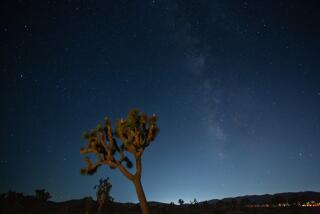Far-Flung Probes Shine Light on Dim Stars
- Share via
For the first time in history, human beings are now able to study pure starlight.
This must seem an odd statement to anyone who has ever looked up at the quiet night sky on a clear, dark night, but it is true.
The trouble with seeing the stars is that, in our solar system, we are located in the near neighborhood of one particular star, the sun, whose light is so much greater than anything else we can see that it drowns out everything.
Of course, half the time, our spinning Earth whirls us into its own shadow. The sun sets, night falls, and the stars emerge. That, however, is not enough. The moon is likely to be in the sky, and it reflects sunlight to such an extent that its light is far stronger than everything else in the night sky put together.
In addition to the moon, there are the bright planets--Mercury, Venus, Mars, Jupiter and Saturn--which also reflect sunlight and, put together, are brighter than all the stars. For that matter, Uranus, Neptune and Pluto, although very dim or even invisible to the unaided eye, also contribute reflected sunlight.
And yet there are times when the moon is not visible in the night sky (that’s true half the time, actually) and there are also times when the planets all happen to be on the daylight side of Earth. This does not happen very often, but it is possible, on rare occasions, to see the night sky minus the moon and the planets.
Can we not see pure starlight then? Unfortunately, no.
There are tens of thousands of asteroids circling the sun, even greater numbers of meteoroids, and an uncertain number of comets as well. All of them reflect sunlight and this significantly dilutes the otherwise pure starlight that we would see.
In fact, there are still worse sources of interfering light. The solar system is a system of bodies, large and small, and some of the “bodies” are very small indeed. They are, in fact, nothing more than dust particles. The solar system, in fact, is a dusty place.
Where does the dust come from? It probably comes from slowly disintegrating comets and from large bodies that occasionally collide and shatter into progressively smaller pieces. Some people estimate that there are 10 trillion tons of dust in the solar system. This is continually being swept up by larger bodies, but it continues to form at the rate of about 10 tons per second, so that the total amount remains steady.
What harm does this do as far as starlight is concerned? Well, the dust reflects sunlight and produces a constant faint light on even the darkest night. The light is brightest in the plane the planets travel in, through the constellations of the zodiac. The light is therefore called “zodiacal light.”
When a telescope points to the night sky, even if the moon and all the planets are absent, and even if you don’t want to count the light of asteroids and comets, some 40% of all the light that reaches the photographic plate is zodiacal light.
What can be done about this? Until now, nothing. However, back in 1972 and 1973, two probes were sent out to Jupiter--Pioneer 10 and Pioneer 11. They did their job and went flying on past Jupiter and are now well beyond the orbits of the planets, still sending back messages.
The dustiness of the solar system decreases as one moves away from the sun, and the two Pioneer probes are now so far from the sun that the zodiacal light is insignificant. With their backs to the sun, the planets and the dust, they are now looking out at the stars, and they detect only the stars and other objects outside the solar system and nothing more (except possibly for the insignificant occasional flicker of light from a distant comet belonging to the solar system).
Gary Toller of NASA’s Goddard Space Flight Center in Greenbelt, Md., has been analyzing the messages sent back by the probes, and he finds that 82% of the light one sees in our sky, as one looks out at the starry universe, is indeed produced by the stars in our own galaxy; almost all of it from stars that are too faint to see with the unaided eye.
However, all stars seem to exist in the midst of dust, so that virtually all starlight is reflected in zodiacal light. Almost all the rest of the light we see is, therefore, not directly from the stars but is starlight that bounces off the dust.






